Janet Roberts's Blog, page 4
November 21, 2016
'Tales of Enchantment' - Tissington Hall - Derbyshire
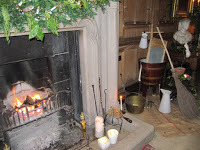 The Christmas decoration last year in this lovely Hall were marvellous (see previous blog) so I was anxious to visit again this year.
The Christmas decoration last year in this lovely Hall were marvellous (see previous blog) so I was anxious to visit again this year.Now the title was 'Tales of Enchantment' and how apt that proved to be! The Main Hall, where you entered, had, like many of the rooms, a roaring welcoming fire, surrounded by articles associated with Cinderella. In pride of place was her lovely ball gown.
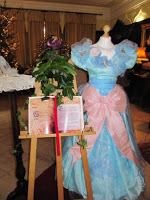

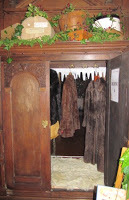 Moving upstairs we entered the Children's Bedroom, as they waited anxiously for A Visit from St Nicholas! However, the room that totally captivated me was the East Drawing Room, set out as The Nutcracker and the Mouse King. At the end was a wardrobe, with the door open, and various garments hanging there - nothing unusual in that I thought. However, what I couldn't understand was, what I took to be a mirror fixed to the back of the wardrobe, didn't seem to reflect what I could see in the room! In fact, I could see snow and icicles! Then I realized that you could actually climb through the wardrobe and be transported to Narnia! How clever was that!
Moving upstairs we entered the Children's Bedroom, as they waited anxiously for A Visit from St Nicholas! However, the room that totally captivated me was the East Drawing Room, set out as The Nutcracker and the Mouse King. At the end was a wardrobe, with the door open, and various garments hanging there - nothing unusual in that I thought. However, what I couldn't understand was, what I took to be a mirror fixed to the back of the wardrobe, didn't seem to reflect what I could see in the room! In fact, I could see snow and icicles! Then I realized that you could actually climb through the wardrobe and be transported to Narnia! How clever was that!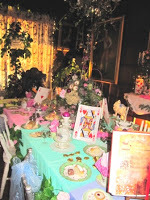
The Dinning Room was transformed into the tea table in Alice in Wonderland - and was full of the most wonderful treats, giant playing cards, and priceless china borrowed from the Hall itself.
I thought it all quite wonderful, and it must have taken hours of preparation and thought - there were just so many things to spot and discover! However, my absolute favourite had to be in the main hall. Here a large, immovable and probably priceless wooden box had been covered, and with the aid of painted wheels, and hoops lit with fairy lights - you knew beyond doubt that this was Cinderella's carriage. So very clever.
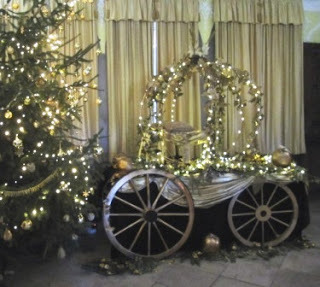 The Hall is only open to the public at the weekends, so if you possibly can, I urge you to go and visit.
The Hall is only open to the public at the weekends, so if you possibly can, I urge you to go and visit.+***
Did you know I now have a web page? Why not take a look by clicking here
Published on November 21, 2016 03:00
October 11, 2016
Center Parcs - Sherwood Forest - Nottinghamshire
It was a long time since I last went and stayed in this Holiday Village, and I was really excited to see what changes had been made - and to know if they had spoilt somewhere I have always enjoyed so much!
The long entrance is still the same, and the booking in arrangements. Finding a car parking space was a challenge, but then it was change-over day with those leaving and those arriving all wanting parking!
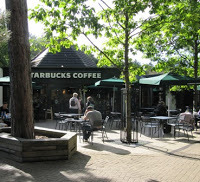 The first change I saw was the arrival of Starbucks - which was in the venue of the delightful little church which I had attended on previous visits. How this seemed to reflect the modern trend. In fact I can remember when there was a big white cross on a hillock within the site, but clearly visible from the nearby A616, and a little shrine on the path leading to the swimming dome, but all religious references have long since gone.
The first change I saw was the arrival of Starbucks - which was in the venue of the delightful little church which I had attended on previous visits. How this seemed to reflect the modern trend. In fact I can remember when there was a big white cross on a hillock within the site, but clearly visible from the nearby A616, and a little shrine on the path leading to the swimming dome, but all religious references have long since gone.
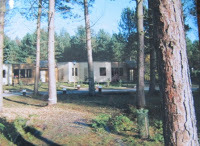 The first thing I noticed was how all the vegetation had grown! Originally the site did look a bit bleak and new
The first thing I noticed was how all the vegetation had grown! Originally the site did look a bit bleak and new
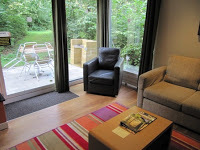 ly planted, but now the majority of the chalets are well hidden, and surprisingly private. One thing that has always impressed me about Center Parcs is the standard of cleanliness inside the villas, considering how heavy the occupancy must be. Ours was absolutely spotless, with even a dish washer in the fully fitted kitchen, and all the beds made up.
ly planted, but now the majority of the chalets are well hidden, and surprisingly private. One thing that has always impressed me about Center Parcs is the standard of cleanliness inside the villas, considering how heavy the occupancy must be. Ours was absolutely spotless, with even a dish washer in the fully fitted kitchen, and all the beds made up.
Of course some things were different - particularly the vastly expensive Tree Houses, but even these had been well camouflaged. The extraordinary thing was that walking in the nature reserve behind these dwellings it was impossible to believe you were just a few miles from the village of Edwinstowe, and really not that far from the city of Nottingham. It was so quiet and peaceful you could have been hundreds of miles from civilization.
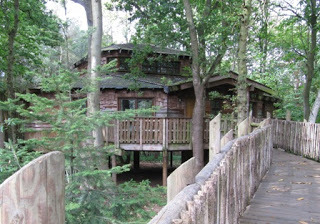
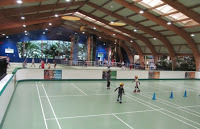
Some things like The Sports Hall and the pool appeared much the same, and were certainly giving the usual amount of pleasure.
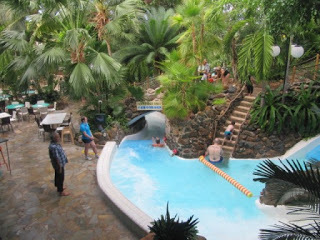
The only thing I was sorry about was having to leave - I could have stayed another couple of weeks, for a weekend just wasn't long enough. How a place with hundreds of visitors can remain so quiet and peaceful is a mystery to me, but it's a perfect place to just unwind and enjoy the wildlife.
***Have you visited my web page yet? Just click here
The long entrance is still the same, and the booking in arrangements. Finding a car parking space was a challenge, but then it was change-over day with those leaving and those arriving all wanting parking!
 The first change I saw was the arrival of Starbucks - which was in the venue of the delightful little church which I had attended on previous visits. How this seemed to reflect the modern trend. In fact I can remember when there was a big white cross on a hillock within the site, but clearly visible from the nearby A616, and a little shrine on the path leading to the swimming dome, but all religious references have long since gone.
The first change I saw was the arrival of Starbucks - which was in the venue of the delightful little church which I had attended on previous visits. How this seemed to reflect the modern trend. In fact I can remember when there was a big white cross on a hillock within the site, but clearly visible from the nearby A616, and a little shrine on the path leading to the swimming dome, but all religious references have long since gone. The first thing I noticed was how all the vegetation had grown! Originally the site did look a bit bleak and new
The first thing I noticed was how all the vegetation had grown! Originally the site did look a bit bleak and new ly planted, but now the majority of the chalets are well hidden, and surprisingly private. One thing that has always impressed me about Center Parcs is the standard of cleanliness inside the villas, considering how heavy the occupancy must be. Ours was absolutely spotless, with even a dish washer in the fully fitted kitchen, and all the beds made up.
ly planted, but now the majority of the chalets are well hidden, and surprisingly private. One thing that has always impressed me about Center Parcs is the standard of cleanliness inside the villas, considering how heavy the occupancy must be. Ours was absolutely spotless, with even a dish washer in the fully fitted kitchen, and all the beds made up.Of course some things were different - particularly the vastly expensive Tree Houses, but even these had been well camouflaged. The extraordinary thing was that walking in the nature reserve behind these dwellings it was impossible to believe you were just a few miles from the village of Edwinstowe, and really not that far from the city of Nottingham. It was so quiet and peaceful you could have been hundreds of miles from civilization.


Some things like The Sports Hall and the pool appeared much the same, and were certainly giving the usual amount of pleasure.

The only thing I was sorry about was having to leave - I could have stayed another couple of weeks, for a weekend just wasn't long enough. How a place with hundreds of visitors can remain so quiet and peaceful is a mystery to me, but it's a perfect place to just unwind and enjoy the wildlife.
***Have you visited my web page yet? Just click here
Published on October 11, 2016 02:26
September 22, 2016
The lost Gardens of Welbeck Abbey - exhibition - Harley Gallery - Nottinghamshire
The Harley Gallery in North Nottinghamshire is holding a small exhibition showing a rare collection of sterescopic autochromes of the Edwardian gardens at Welbeck Abbey. This is in celebration of 'The Year of the Garden'.
Welbeck has a long history of stunning gardens and as far back as 1704 arrangements were being made for the Gardener, a John Watts, to find and furnish Welbeck Gardens and Orchards with all manner of truit trees viz the south walls with peach trees, nectarine trees and apricot trees; the other walls with pears, plums and cherry trees, the best of all kinds. In addition 'The borders set with pinks both in gardens and courts or some other beautiful flowers amongs the pinks'.
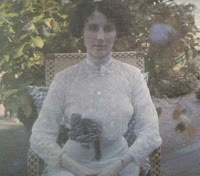 Welbeck has had a chequered history and by 1879 it was in a state of disrepair, with only four or five rooms in the west wing being habitable by the 5th Duke. However, the 6th Duke repaired the house, and it became notable as a centre of late Victorian and Edwardian upper-class society. He married Winifred Anna Dallas-Yorke in 1889, and the Duchess set about improving the grounds with the help of her good friend the garden designer Norah Lindsay. They also consulted dsigner Harold Peto and flower painter Alfred Parsons
Welbeck has had a chequered history and by 1879 it was in a state of disrepair, with only four or five rooms in the west wing being habitable by the 5th Duke. However, the 6th Duke repaired the house, and it became notable as a centre of late Victorian and Edwardian upper-class society. He married Winifred Anna Dallas-Yorke in 1889, and the Duchess set about improving the grounds with the help of her good friend the garden designer Norah Lindsay. They also consulted dsigner Harold Peto and flower painter Alfred Parsons
 In 1902 Sir Ernest George added stone balustrades and benches, a great fountain, flights of steps and a tea house. These provided a perfect frame for spectacular displays of seasonal bedding
In 1902 Sir Ernest George added stone balustrades and benches, a great fountain, flights of steps and a tea house. These provided a perfect frame for spectacular displays of seasonal bedding
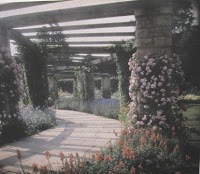 About 1903 a great double herbaceous border was planted between clipped yew hedges and mature lime trees. Each border was 15 feet wide and about 660 feet long, giving the planting an astonishing total length of a quarter of a mile. Unusually for the time, large drifts of white, cream and pale yellow flowers provided a background for smaller blocks of brilliant, contrasting colours. The standard of cultivation was unsurpassed and many thousands of plants were individually staked and supported.
About 1903 a great double herbaceous border was planted between clipped yew hedges and mature lime trees. Each border was 15 feet wide and about 660 feet long, giving the planting an astonishing total length of a quarter of a mile. Unusually for the time, large drifts of white, cream and pale yellow flowers provided a background for smaller blocks of brilliant, contrasting colours. The standard of cultivation was unsurpassed and many thousands of plants were individually staked and supported.
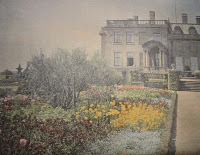 A number of ornamental flourishes decorated the borders including vases for the 1st Earl of Portland's estate in Holland, which were set in recesses. A venetian foutain stood at a central point surrounded by clipped golden yew, and the borders ended with an ornamental, painted and gilded wrought-iron screen.
A number of ornamental flourishes decorated the borders including vases for the 1st Earl of Portland's estate in Holland, which were set in recesses. A venetian foutain stood at a central point surrounded by clipped golden yew, and the borders ended with an ornamental, painted and gilded wrought-iron screen.
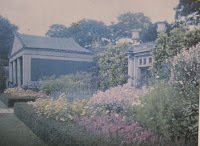 In 1909 work began on a Sunken Garden, with twin summer houses overlooking two pools surrounded by a paved pergola. Set apart from the rest of the gardens and mysterious in atmosphere, cascades of climbing roses and hosts of herbaceous plants created a sense of romantic generosity and abundance.
In 1909 work began on a Sunken Garden, with twin summer houses overlooking two pools surrounded by a paved pergola. Set apart from the rest of the gardens and mysterious in atmosphere, cascades of climbing roses and hosts of herbaceous plants created a sense of romantic generosity and abundance.
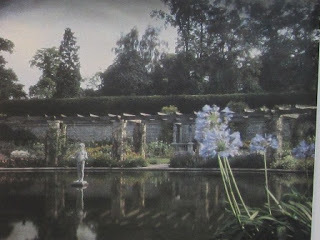 How I would have loved to have seen these gardens! If they could be restored what a tourist attraction they would be! However, that seems very unlikely not least because Welbeck must be one of the most secret, private estates left in the country, and it's impossible to even glimpse the Abbey, let alone get into the gardens!
How I would have loved to have seen these gardens! If they could be restored what a tourist attraction they would be! However, that seems very unlikely not least because Welbeck must be one of the most secret, private estates left in the country, and it's impossible to even glimpse the Abbey, let alone get into the gardens!
This rare exhibition only continues until October 23rd 2016***Nearby is the estate of the owned at this time by the Duke of Newcastle. To read of the 4th Duke's tragic life just click here
Welbeck has a long history of stunning gardens and as far back as 1704 arrangements were being made for the Gardener, a John Watts, to find and furnish Welbeck Gardens and Orchards with all manner of truit trees viz the south walls with peach trees, nectarine trees and apricot trees; the other walls with pears, plums and cherry trees, the best of all kinds. In addition 'The borders set with pinks both in gardens and courts or some other beautiful flowers amongs the pinks'.
 Welbeck has had a chequered history and by 1879 it was in a state of disrepair, with only four or five rooms in the west wing being habitable by the 5th Duke. However, the 6th Duke repaired the house, and it became notable as a centre of late Victorian and Edwardian upper-class society. He married Winifred Anna Dallas-Yorke in 1889, and the Duchess set about improving the grounds with the help of her good friend the garden designer Norah Lindsay. They also consulted dsigner Harold Peto and flower painter Alfred Parsons
Welbeck has had a chequered history and by 1879 it was in a state of disrepair, with only four or five rooms in the west wing being habitable by the 5th Duke. However, the 6th Duke repaired the house, and it became notable as a centre of late Victorian and Edwardian upper-class society. He married Winifred Anna Dallas-Yorke in 1889, and the Duchess set about improving the grounds with the help of her good friend the garden designer Norah Lindsay. They also consulted dsigner Harold Peto and flower painter Alfred Parsons In 1902 Sir Ernest George added stone balustrades and benches, a great fountain, flights of steps and a tea house. These provided a perfect frame for spectacular displays of seasonal bedding
In 1902 Sir Ernest George added stone balustrades and benches, a great fountain, flights of steps and a tea house. These provided a perfect frame for spectacular displays of seasonal bedding About 1903 a great double herbaceous border was planted between clipped yew hedges and mature lime trees. Each border was 15 feet wide and about 660 feet long, giving the planting an astonishing total length of a quarter of a mile. Unusually for the time, large drifts of white, cream and pale yellow flowers provided a background for smaller blocks of brilliant, contrasting colours. The standard of cultivation was unsurpassed and many thousands of plants were individually staked and supported.
About 1903 a great double herbaceous border was planted between clipped yew hedges and mature lime trees. Each border was 15 feet wide and about 660 feet long, giving the planting an astonishing total length of a quarter of a mile. Unusually for the time, large drifts of white, cream and pale yellow flowers provided a background for smaller blocks of brilliant, contrasting colours. The standard of cultivation was unsurpassed and many thousands of plants were individually staked and supported. A number of ornamental flourishes decorated the borders including vases for the 1st Earl of Portland's estate in Holland, which were set in recesses. A venetian foutain stood at a central point surrounded by clipped golden yew, and the borders ended with an ornamental, painted and gilded wrought-iron screen.
A number of ornamental flourishes decorated the borders including vases for the 1st Earl of Portland's estate in Holland, which were set in recesses. A venetian foutain stood at a central point surrounded by clipped golden yew, and the borders ended with an ornamental, painted and gilded wrought-iron screen. In 1909 work began on a Sunken Garden, with twin summer houses overlooking two pools surrounded by a paved pergola. Set apart from the rest of the gardens and mysterious in atmosphere, cascades of climbing roses and hosts of herbaceous plants created a sense of romantic generosity and abundance.
In 1909 work began on a Sunken Garden, with twin summer houses overlooking two pools surrounded by a paved pergola. Set apart from the rest of the gardens and mysterious in atmosphere, cascades of climbing roses and hosts of herbaceous plants created a sense of romantic generosity and abundance. How I would have loved to have seen these gardens! If they could be restored what a tourist attraction they would be! However, that seems very unlikely not least because Welbeck must be one of the most secret, private estates left in the country, and it's impossible to even glimpse the Abbey, let alone get into the gardens!
How I would have loved to have seen these gardens! If they could be restored what a tourist attraction they would be! However, that seems very unlikely not least because Welbeck must be one of the most secret, private estates left in the country, and it's impossible to even glimpse the Abbey, let alone get into the gardens!This rare exhibition only continues until October 23rd 2016***Nearby is the estate of the owned at this time by the Duke of Newcastle. To read of the 4th Duke's tragic life just click here
Published on September 22, 2016 05:57
September 18, 2016
'Beyond Limits' - Sculpture exhibition - Chatsworth - Derbyshire
This is always a fixed point in my annual calendar ( see previous blog.) and is now considered one of the leading events in the artistic calendar, showcasing the work of artists from around the world. They claim that the diversity of these international artists represent some of the most original contemporary and monumental sculpture being made today.
This year there were some 19 works of art dotted around the105 acre garden. Here are just a few of my favourites.
 On, or around the cascade, is always a favourite siting point for striking sculptures, and this year was no exception. This is Fernando Botero's Donna Sdraiata. Conceived in 2012 it is cast in bronze. Revelling in her glorious voluptuousness this is a magnificent example of the sculptor's celebration of the female nude
On, or around the cascade, is always a favourite siting point for striking sculptures, and this year was no exception. This is Fernando Botero's Donna Sdraiata. Conceived in 2012 it is cast in bronze. Revelling in her glorious voluptuousness this is a magnificent example of the sculptor's celebration of the female nude
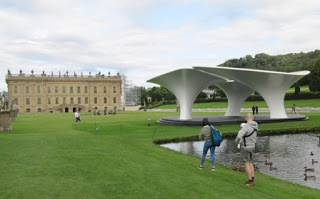 There is always a striking sculpture near the house and this year was certainly no exception! 'Lilas' by Zaha Hadid was conceived and executed in tensile fabric and steel in 2007 and was described as 'unique' - which it certainly was. She is famous for creating highly expressive, sweeping forms that evoke the flux of contemporary life.
There is always a striking sculpture near the house and this year was certainly no exception! 'Lilas' by Zaha Hadid was conceived and executed in tensile fabric and steel in 2007 and was described as 'unique' - which it certainly was. She is famous for creating highly expressive, sweeping forms that evoke the flux of contemporary life.
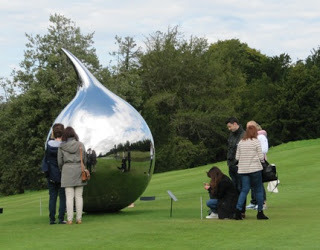 'Tear' created by Yorkhsireman Richard Hudson was conceived and executed in steel in 2016, and exemplifies his perceptive and innovative use of materials. It is a whimsical exploration of the protean properties of a teardrop and the reflective surface means that the particular environment and situation of the viewer is fundamental to their experience of the work.
'Tear' created by Yorkhsireman Richard Hudson was conceived and executed in steel in 2016, and exemplifies his perceptive and innovative use of materials. It is a whimsical exploration of the protean properties of a teardrop and the reflective surface means that the particular environment and situation of the viewer is fundamental to their experience of the work.
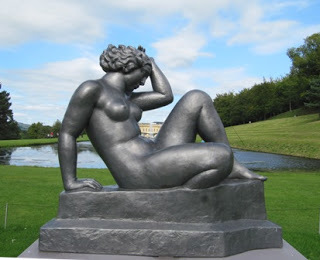 La Montagne, premier etat by Aristide Maillol is cast in lead and is the culmination of the artist's interest in the form of the seated female nude. The sheer size of the work renders it extremely powerful but the soft lines, sinuous curves and gentle features make it a statement of elegance and poise.
La Montagne, premier etat by Aristide Maillol is cast in lead and is the culmination of the artist's interest in the form of the seated female nude. The sheer size of the work renders it extremely powerful but the soft lines, sinuous curves and gentle features make it a statement of elegance and poise.
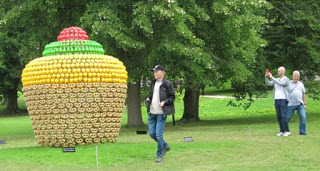 Certainly the most colourful, and the one attracting the most attention was 'Fruitcake' created by Joana Vasconcelos. It was conceived and executed in plastic moulds and stainless steel in 2011, and again the work was described as 'unique'. It is part of Vasconcelos's 'Treats' series, in which the artist explores ideas and imagery which pertain to our contemporary consumerist culture. The monumental form of a cupcake is outlined via a steel frame and built up from plastic moulds typically used by children when playing with sand.
Certainly the most colourful, and the one attracting the most attention was 'Fruitcake' created by Joana Vasconcelos. It was conceived and executed in plastic moulds and stainless steel in 2011, and again the work was described as 'unique'. It is part of Vasconcelos's 'Treats' series, in which the artist explores ideas and imagery which pertain to our contemporary consumerist culture. The monumental form of a cupcake is outlined via a steel frame and built up from plastic moulds typically used by children when playing with sand.
More information about any of these, and the other works in the exhibition can be obtained from Sotherbys.com
This year there were some 19 works of art dotted around the105 acre garden. Here are just a few of my favourites.
 On, or around the cascade, is always a favourite siting point for striking sculptures, and this year was no exception. This is Fernando Botero's Donna Sdraiata. Conceived in 2012 it is cast in bronze. Revelling in her glorious voluptuousness this is a magnificent example of the sculptor's celebration of the female nude
On, or around the cascade, is always a favourite siting point for striking sculptures, and this year was no exception. This is Fernando Botero's Donna Sdraiata. Conceived in 2012 it is cast in bronze. Revelling in her glorious voluptuousness this is a magnificent example of the sculptor's celebration of the female nude There is always a striking sculpture near the house and this year was certainly no exception! 'Lilas' by Zaha Hadid was conceived and executed in tensile fabric and steel in 2007 and was described as 'unique' - which it certainly was. She is famous for creating highly expressive, sweeping forms that evoke the flux of contemporary life.
There is always a striking sculpture near the house and this year was certainly no exception! 'Lilas' by Zaha Hadid was conceived and executed in tensile fabric and steel in 2007 and was described as 'unique' - which it certainly was. She is famous for creating highly expressive, sweeping forms that evoke the flux of contemporary life. 'Tear' created by Yorkhsireman Richard Hudson was conceived and executed in steel in 2016, and exemplifies his perceptive and innovative use of materials. It is a whimsical exploration of the protean properties of a teardrop and the reflective surface means that the particular environment and situation of the viewer is fundamental to their experience of the work.
'Tear' created by Yorkhsireman Richard Hudson was conceived and executed in steel in 2016, and exemplifies his perceptive and innovative use of materials. It is a whimsical exploration of the protean properties of a teardrop and the reflective surface means that the particular environment and situation of the viewer is fundamental to their experience of the work. La Montagne, premier etat by Aristide Maillol is cast in lead and is the culmination of the artist's interest in the form of the seated female nude. The sheer size of the work renders it extremely powerful but the soft lines, sinuous curves and gentle features make it a statement of elegance and poise.
La Montagne, premier etat by Aristide Maillol is cast in lead and is the culmination of the artist's interest in the form of the seated female nude. The sheer size of the work renders it extremely powerful but the soft lines, sinuous curves and gentle features make it a statement of elegance and poise. Certainly the most colourful, and the one attracting the most attention was 'Fruitcake' created by Joana Vasconcelos. It was conceived and executed in plastic moulds and stainless steel in 2011, and again the work was described as 'unique'. It is part of Vasconcelos's 'Treats' series, in which the artist explores ideas and imagery which pertain to our contemporary consumerist culture. The monumental form of a cupcake is outlined via a steel frame and built up from plastic moulds typically used by children when playing with sand.
Certainly the most colourful, and the one attracting the most attention was 'Fruitcake' created by Joana Vasconcelos. It was conceived and executed in plastic moulds and stainless steel in 2011, and again the work was described as 'unique'. It is part of Vasconcelos's 'Treats' series, in which the artist explores ideas and imagery which pertain to our contemporary consumerist culture. The monumental form of a cupcake is outlined via a steel frame and built up from plastic moulds typically used by children when playing with sand. More information about any of these, and the other works in the exhibition can be obtained from Sotherbys.com
Published on September 18, 2016 02:28
September 15, 2016
Conservatory - Barbican - London
It was quite by chance that I spotted a little piece in the newspaper saying that the Barbican, the renown arts
 centre in London, had a conservatory. I didn't know that! It was open between 12 and 4pm Sunday afternoons, and Bank Holiday Mondays.
centre in London, had a conservatory. I didn't know that! It was open between 12 and 4pm Sunday afternoons, and Bank Holiday Mondays.
So I made a special journey over to visit, this the 2nd biggest conservatory in London. Not only are there exotic fish but over 2,000 tropical plants, that you can view from different level walkways.
This photograph - taken from one of the notice boards, was taken in 1976 and shows the organised chaos which reigned during the construction of the Barbican Arts Centre.
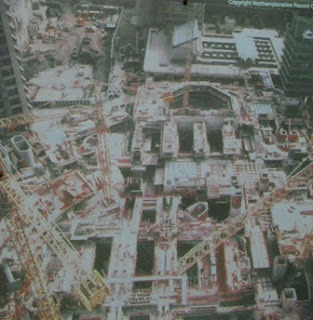 Here the photograph shows the
Here the photograph shows the
arrval of the plants. conservatory shortly after the plants arrived. A pipe supported by a ladder was used for blowing hot air into the conservatory, since the plants rather unfortunately arrived in cold weather before installation of the conservatory glazing had been finished.

I was a little disappointed that so few of the plants were labelled, but this was an exception and is apparently a Hedychium gardnerianum, and is a cultivated ginger. The cylindrical flower spike is very fragrant, and distinguished by its long red stamens. The plant can be invasive, out of its natural area, and has become a weed in the native forest of Hawaii. The whole plant can be used medicinally for treating digestive troubles and also as an antiseptic.
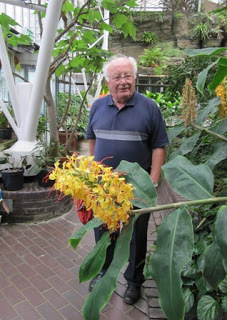
I particularly liked the pools, full of lovely fish, although it was not possible to get very close to them.
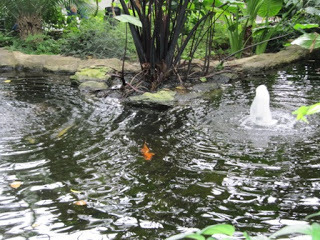
Right in the centre of the conservatory was a lovely area set with tables and chairs, and did I fancy having cream tea there - in fact I couldn't think of anything lovelier! However, despite the fact that most of the tables were unoccupied, I was told I couldn't have one, as you had to book on-line. What a crazy system! I would have thought a customer was a customer and they would have been glad to take my money.
Instead I went downstair for a cup of tea, and as the cafe was packed I sat at a table outside, but the pigeons were just awful, hopping all over the tables and pecking at plates - I just hated that.
***Please take a look at my web page by clicking here
 centre in London, had a conservatory. I didn't know that! It was open between 12 and 4pm Sunday afternoons, and Bank Holiday Mondays.
centre in London, had a conservatory. I didn't know that! It was open between 12 and 4pm Sunday afternoons, and Bank Holiday Mondays.So I made a special journey over to visit, this the 2nd biggest conservatory in London. Not only are there exotic fish but over 2,000 tropical plants, that you can view from different level walkways.
This photograph - taken from one of the notice boards, was taken in 1976 and shows the organised chaos which reigned during the construction of the Barbican Arts Centre.
 Here the photograph shows the
Here the photograph shows thearrval of the plants. conservatory shortly after the plants arrived. A pipe supported by a ladder was used for blowing hot air into the conservatory, since the plants rather unfortunately arrived in cold weather before installation of the conservatory glazing had been finished.

I was a little disappointed that so few of the plants were labelled, but this was an exception and is apparently a Hedychium gardnerianum, and is a cultivated ginger. The cylindrical flower spike is very fragrant, and distinguished by its long red stamens. The plant can be invasive, out of its natural area, and has become a weed in the native forest of Hawaii. The whole plant can be used medicinally for treating digestive troubles and also as an antiseptic.

I particularly liked the pools, full of lovely fish, although it was not possible to get very close to them.

Right in the centre of the conservatory was a lovely area set with tables and chairs, and did I fancy having cream tea there - in fact I couldn't think of anything lovelier! However, despite the fact that most of the tables were unoccupied, I was told I couldn't have one, as you had to book on-line. What a crazy system! I would have thought a customer was a customer and they would have been glad to take my money.
Instead I went downstair for a cup of tea, and as the cafe was packed I sat at a table outside, but the pigeons were just awful, hopping all over the tables and pecking at plates - I just hated that.
***Please take a look at my web page by clicking here
Published on September 15, 2016 03:57
September 13, 2016
'Blaze of Glory' - model burning - Gt Fire of London
About midnight on 2nd September 1666 a fire started in the King's bakery in Pudding Lane, near London Bridge, after baker Thomas Farriner had left is oven lit, and gone to bed. Fires were a common occurrence at the time, and were soon quelled. However, that summer had been very hot, with no rain for weeks, so the nearby wooden houses were tinder dry.
 The fire soon took hold, with a strong east wind spread flames further, jumping from house to house. Over 300 houses quickly collapsed, and panic began to spread through the city. People poured down to the River Thames in an attempt to escape by boat. By the next day half of London was in flames, until finally gunpowder was used to blow up houses that were in the path of the fire, intending to create a fire-break. St. Paul's Cathedral was caught in the flames and acres of lead on the roof melted and poured down on to the street like a silver river, and the great cathedral collapsed.
The fire soon took hold, with a strong east wind spread flames further, jumping from house to house. Over 300 houses quickly collapsed, and panic began to spread through the city. People poured down to the River Thames in an attempt to escape by boat. By the next day half of London was in flames, until finally gunpowder was used to blow up houses that were in the path of the fire, intending to create a fire-break. St. Paul's Cathedral was caught in the flames and acres of lead on the roof melted and poured down on to the street like a silver river, and the great cathedral collapsed.
Altogether 13,000 private dwellings had been destroyed, together with virtually all the civic buildings. Only one fifth of London was left standing, and yet incredibly only six people died.
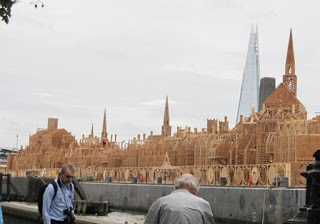 This year, to mark the 350th anniversary of the Great Fire a 120-metre barge bearing 190 replica 17th-century buildings floated just down from Hammersmith Bridge. Hundreds of schoolchildren and young people from the inner London boroughs worked alongside highly-skilled carpenters to create this remarkable 17th century London skyline. It was the creation of David Best, a San Franciscan artist who, with the help of volunteers builds vast wooden structures which are then set on fire.
This year, to mark the 350th anniversary of the Great Fire a 120-metre barge bearing 190 replica 17th-century buildings floated just down from Hammersmith Bridge. Hundreds of schoolchildren and young people from the inner London boroughs worked alongside highly-skilled carpenters to create this remarkable 17th century London skyline. It was the creation of David Best, a San Franciscan artist who, with the help of volunteers builds vast wooden structures which are then set on fire.
 I thought it absolutely beautiful, and really felt quite sad that it was going to be symbolically destroyed. I was fortunate enough to see it both from the Embankment and from a river cruise.
I thought it absolutely beautiful, and really felt quite sad that it was going to be symbolically destroyed. I was fortunate enough to see it both from the Embankment and from a river cruise.
I was unable to watch the final fire, but probably watching it on TV or on YouTube gives a clearer impression than being squashed in the great crowds standing on the embankment.
***Have you visited my web page yet? Just click here
 The fire soon took hold, with a strong east wind spread flames further, jumping from house to house. Over 300 houses quickly collapsed, and panic began to spread through the city. People poured down to the River Thames in an attempt to escape by boat. By the next day half of London was in flames, until finally gunpowder was used to blow up houses that were in the path of the fire, intending to create a fire-break. St. Paul's Cathedral was caught in the flames and acres of lead on the roof melted and poured down on to the street like a silver river, and the great cathedral collapsed.
The fire soon took hold, with a strong east wind spread flames further, jumping from house to house. Over 300 houses quickly collapsed, and panic began to spread through the city. People poured down to the River Thames in an attempt to escape by boat. By the next day half of London was in flames, until finally gunpowder was used to blow up houses that were in the path of the fire, intending to create a fire-break. St. Paul's Cathedral was caught in the flames and acres of lead on the roof melted and poured down on to the street like a silver river, and the great cathedral collapsed.Altogether 13,000 private dwellings had been destroyed, together with virtually all the civic buildings. Only one fifth of London was left standing, and yet incredibly only six people died.
 This year, to mark the 350th anniversary of the Great Fire a 120-metre barge bearing 190 replica 17th-century buildings floated just down from Hammersmith Bridge. Hundreds of schoolchildren and young people from the inner London boroughs worked alongside highly-skilled carpenters to create this remarkable 17th century London skyline. It was the creation of David Best, a San Franciscan artist who, with the help of volunteers builds vast wooden structures which are then set on fire.
This year, to mark the 350th anniversary of the Great Fire a 120-metre barge bearing 190 replica 17th-century buildings floated just down from Hammersmith Bridge. Hundreds of schoolchildren and young people from the inner London boroughs worked alongside highly-skilled carpenters to create this remarkable 17th century London skyline. It was the creation of David Best, a San Franciscan artist who, with the help of volunteers builds vast wooden structures which are then set on fire. I thought it absolutely beautiful, and really felt quite sad that it was going to be symbolically destroyed. I was fortunate enough to see it both from the Embankment and from a river cruise.
I thought it absolutely beautiful, and really felt quite sad that it was going to be symbolically destroyed. I was fortunate enough to see it both from the Embankment and from a river cruise. I was unable to watch the final fire, but probably watching it on TV or on YouTube gives a clearer impression than being squashed in the great crowds standing on the embankment.
***Have you visited my web page yet? Just click here
Published on September 13, 2016 03:00
September 10, 2016
Parkrun - Brierley Forest Park - Nottinghamshire
Parkrun was founded by Paul Sinton-Hewitt in 2004, when he held the first run in Bushy Park, London. On the 2nd October 13 intrepid runners ran round the park. It was two years before parkrun spread any further, with Wimbledon chosen for the second event, which proved they could manage more than a single
event at a time.
To begin with all results were collated on paper and the finish tokens were washers from the local hardware store! Eventually they ramped up the technology, and now there's an efficient registration and barcode result system in operation.
 Now many thousands of runners, and many countries, are processed, websites updated and emails sent each week, yet the simple concept remains the same - weekly, free, 5km, for everyone, forever - how absolutely marvellous!
Now many thousands of runners, and many countries, are processed, websites updated and emails sent each week, yet the simple concept remains the same - weekly, free, 5km, for everyone, forever - how absolutely marvellous!
Brirely Park was packed for this their first event, which had taken months in the planning. Enthusiastic runners from considerable distances congregated near the Visitor Centre, before being set off on their 5k run round the park.
***Mansfield has another claim to fame! Read about it here
event at a time.
To begin with all results were collated on paper and the finish tokens were washers from the local hardware store! Eventually they ramped up the technology, and now there's an efficient registration and barcode result system in operation.
 Now many thousands of runners, and many countries, are processed, websites updated and emails sent each week, yet the simple concept remains the same - weekly, free, 5km, for everyone, forever - how absolutely marvellous!
Now many thousands of runners, and many countries, are processed, websites updated and emails sent each week, yet the simple concept remains the same - weekly, free, 5km, for everyone, forever - how absolutely marvellous!Brirely Park was packed for this their first event, which had taken months in the planning. Enthusiastic runners from considerable distances congregated near the Visitor Centre, before being set off on their 5k run round the park.
***Mansfield has another claim to fame! Read about it here
Published on September 10, 2016 23:54
September 8, 2016
'Dominoes' - Totally Thames Festival - London
This was an incredible sculpture created by Station House Opera, when thousands of breeze blocks were lined up throughout the Square Mile of the city of London. Starting off at a single location, the domino line then split into three, each line threading its way through the historical and everyday parts of the City, linking areas in a symbolic as well as physical chain of cause and effect, tracing paths through the city as did the Great Fire of London in 1666.
What made it even more special for me was that when I arrived at St Paul's to watch some of the 600 volunteers erecting the breeze blocks,the bells of St Paul's Cathedral were pealing, and sounding quite wonderful.
At 6.30pm I was back, joining the crowds at the side of the Cathedral. We could hear from the walkie-talkies carried by the volunteers that the blocks had begun to fall, and they were approaching - fast. Then we heard cheering from St Paul's, and then they were with us!
I thought that was the end, but no-one moved, and I was so glad I stayed a bit longer, as this then happened!
***Have you looked at my web page yet? Just click here
What made it even more special for me was that when I arrived at St Paul's to watch some of the 600 volunteers erecting the breeze blocks,the bells of St Paul's Cathedral were pealing, and sounding quite wonderful.
At 6.30pm I was back, joining the crowds at the side of the Cathedral. We could hear from the walkie-talkies carried by the volunteers that the blocks had begun to fall, and they were approaching - fast. Then we heard cheering from St Paul's, and then they were with us!
I thought that was the end, but no-one moved, and I was so glad I stayed a bit longer, as this then happened!
***Have you looked at my web page yet? Just click here
Published on September 08, 2016 02:47
September 2, 2016
Peter Ball - 'Southwell Revisited' Sculpture exhibition - Nottinghamshire
 I was familiar with the striking sculptures by this very talented artist as his 'Christus Rex' has been suspended above the chancel entrance since 1987, and
I was familiar with the striking sculptures by this very talented artist as his 'Christus Rex' has been suspended above the chancel entrance since 1987, and
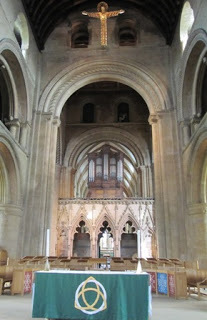 has always struck me as very fine, so I was keen to see more of his work.
has always struck me as very fine, so I was keen to see more of his work.Peter Eugene Ball has been making sculpture for the past 50 years, and is probably best known for his religious work. He currently has more than 70 pieces in cathedrals and churches up and down the country - almost certainly more than any other living artist. His work is mainly figurative and frequently made from found objects, predominantly wood, often partly covered in copper or pewter and embellished with silver and gold leaf. They certainly look totally unique.
The exhibition is held in Southwell Minster's marvellous Chapter House, both the passage way and the octagonal space, and there are masses of them! I found it hard to choose just a few for this blog, as really I was attracted to most of them, they had such movement and appeal, but this is my final selection:
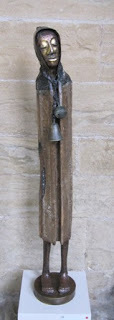 Hooded Man
Hooded Man Salome
Salome Oxford MadonnaIf you possibly can I would urge you to go to this superb exhibition and to see his other works within the Cathedral, but you need to be quick - the exhibition finished on Thursday 8th September 2016.
Oxford MadonnaIf you possibly can I would urge you to go to this superb exhibition and to see his other works within the Cathedral, but you need to be quick - the exhibition finished on Thursday 8th September 2016.***Have you taken a look at my web page yet? Just click here
Published on September 02, 2016 12:00
August 22, 2016
Sculpture at Doddington Hall part 2 - Lincolnshire
I always knew I would have to go back to Doddington Hall - it just wasn't possible to admire 373 sculptures in one visit. Again I was overwhelmed by the amount of sheer planing and work that must have gone into this exhibition, for every piece was in exactly the right place to display it perfectly. Also, of course there was the whole question of securing the pieces safely, and many were really monumental - an incredible feat of engineering just to get them into position.
Here again are a few of the pieces that caught my eye on this visit.
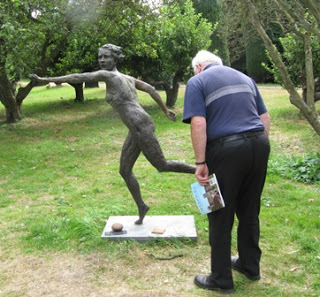
179. Daphne - Bronze
Louisa Forbes
£22800
The small information board on the base read:
'Dàphne - From Ovid's Metamorphosis. The wood nymph Daphne runs to escape Apollo. She screams to her father to save her. As Apollos' hand touches her, she is transformed into a Laurel Tree. He claims victory and crown himself with her leaves.
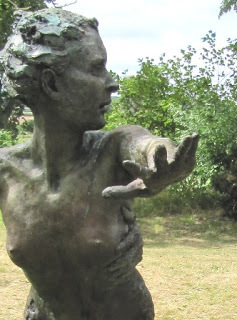 I then saw that there was indeed a hand round her rib cage, which I actually thought quite creepy!
I then saw that there was indeed a hand round her rib cage, which I actually thought quite creepy!
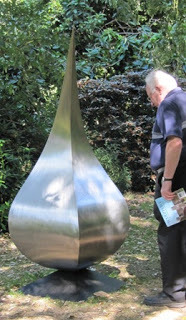

318 Square P:ear - Stainless steel
Richard Cresswell
£2210
74 Greer - Guardian Angel
Wood (cedar) Ed Elliott
£16250
The long description with this rather lovely sculpture, set so well in the middle of the unusual turf maze, explains that the name 'Greer' comes from the Celtic/Gaelic meaning for 'Watchful' or 'Guardian'. It goes on to say 'Displaying a lack of features, the character emphasizes the mysterious, beautiful presence that quietly dominates the space around it. Faceless yet arresting in its eloquent stillness, its body language commands attention and engages the imagination.'
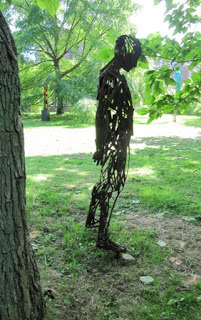
372 Think it Through.
Mild Steel
Tobias Ford
£6000
There were a whole group of these figures standing quietly under the trees and they really appealed to me.
And finally, this rather lovely, tranquil sculpture called 'We three' made in resin granite by Donald Fooley - £2730.
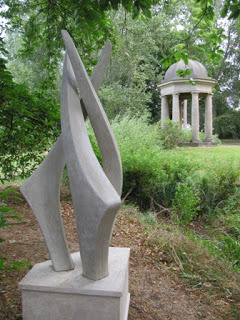 Just a reminder - this amazing sculpture exhibition, which is free, there's just a garden entrance fee, ends September 11th 2016.
Just a reminder - this amazing sculpture exhibition, which is free, there's just a garden entrance fee, ends September 11th 2016.
***
I've written a number of e-books, and this link explains one of my childrens' books, which I think tells an important story. Just click here
Here again are a few of the pieces that caught my eye on this visit.

179. Daphne - Bronze
Louisa Forbes
£22800
The small information board on the base read:
'Dàphne - From Ovid's Metamorphosis. The wood nymph Daphne runs to escape Apollo. She screams to her father to save her. As Apollos' hand touches her, she is transformed into a Laurel Tree. He claims victory and crown himself with her leaves.
 I then saw that there was indeed a hand round her rib cage, which I actually thought quite creepy!
I then saw that there was indeed a hand round her rib cage, which I actually thought quite creepy!

318 Square P:ear - Stainless steel
Richard Cresswell
£2210
74 Greer - Guardian Angel
Wood (cedar) Ed Elliott
£16250
The long description with this rather lovely sculpture, set so well in the middle of the unusual turf maze, explains that the name 'Greer' comes from the Celtic/Gaelic meaning for 'Watchful' or 'Guardian'. It goes on to say 'Displaying a lack of features, the character emphasizes the mysterious, beautiful presence that quietly dominates the space around it. Faceless yet arresting in its eloquent stillness, its body language commands attention and engages the imagination.'

372 Think it Through.
Mild Steel
Tobias Ford
£6000
There were a whole group of these figures standing quietly under the trees and they really appealed to me.
And finally, this rather lovely, tranquil sculpture called 'We three' made in resin granite by Donald Fooley - £2730.
 Just a reminder - this amazing sculpture exhibition, which is free, there's just a garden entrance fee, ends September 11th 2016.
Just a reminder - this amazing sculpture exhibition, which is free, there's just a garden entrance fee, ends September 11th 2016.***
I've written a number of e-books, and this link explains one of my childrens' books, which I think tells an important story. Just click here
Published on August 22, 2016 05:36



